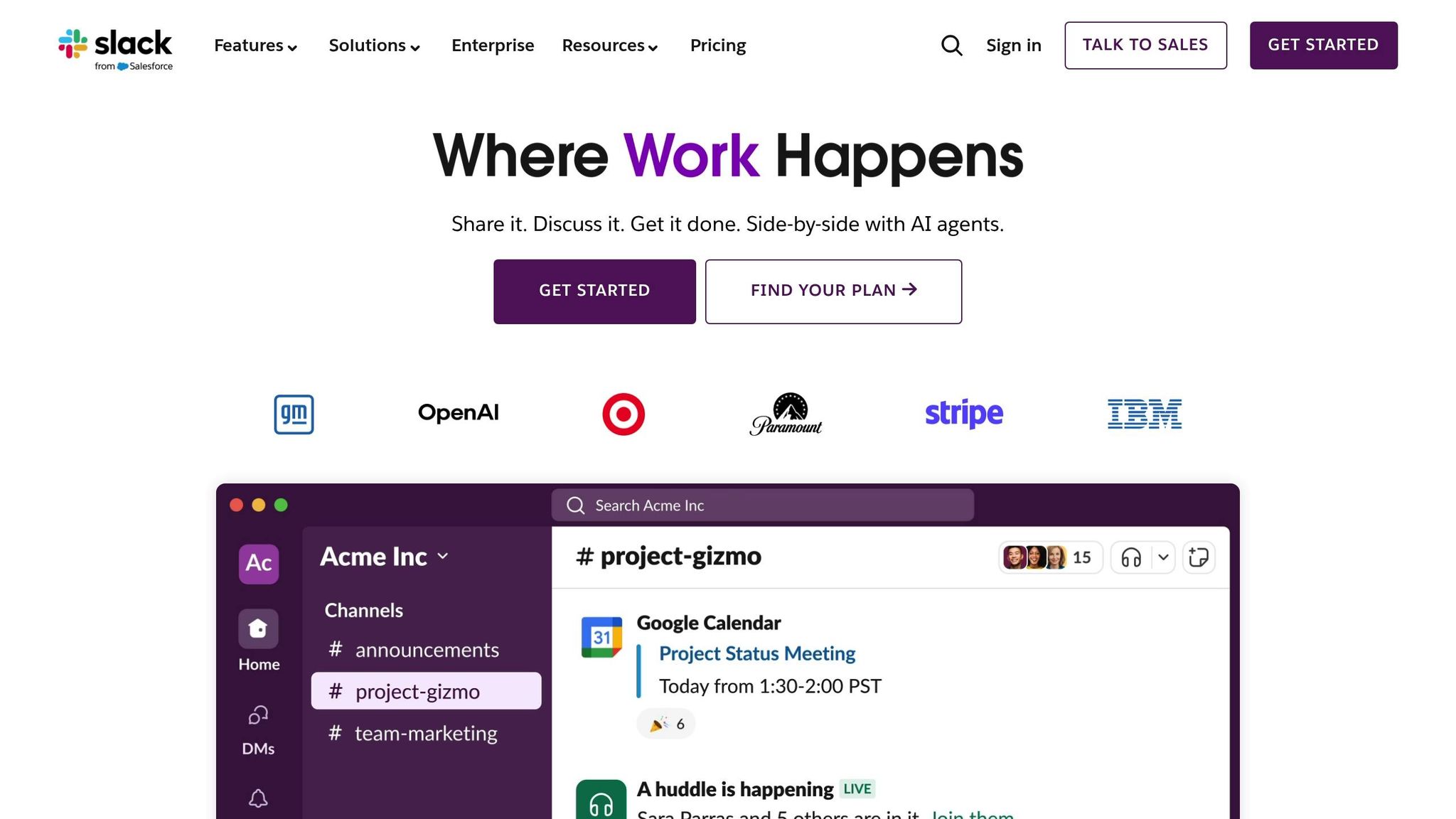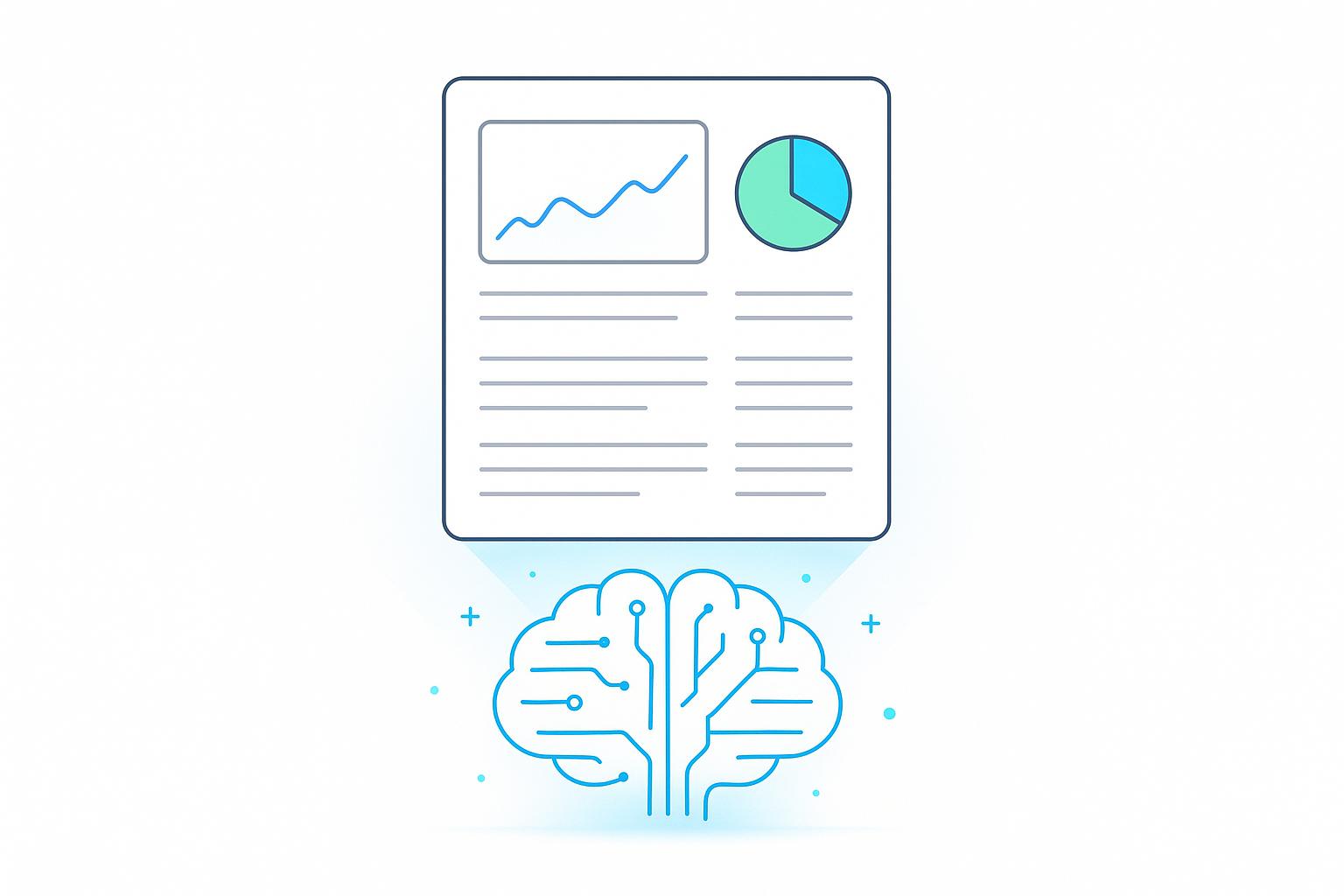Startups need tailored financial reports to meet the unique needs of investors, board members, and internal teams. Generic reports often fail to provide the right insights, leading to missed opportunities and slower decision-making. Customization ensures each stakeholder gets relevant, actionable data.
Key Takeaways:
- Investors focus on metrics like cash runway, burn rate, and profitability forecasts. They prefer concise, visual dashboards updated quarterly.
- Board members require high-level overviews of revenue, expenses, and risk assessments to guide long-term strategy.
- Internal teams need real-time data for daily operations, such as budget variances and cash flow management.
AI tools simplify this process by automating data collection, ensuring accuracy, and delivering insights directly via platforms like Slack. These tools help startups save time, reduce errors, and maintain transparency with stakeholders. By addressing specific reporting needs, businesses can make faster, smarter decisions and strengthen relationships with their key audiences.
Automate Your Finance Reports In 20 Minutes Or Less
Different Stakeholder Reporting Requirements
Each stakeholder has unique expectations when it comes to metrics, timelines, and the level of detail they need for decision-making. Meeting these requirements can be the difference between creating reports that lead to action and those that get ignored.
What Investors Need in Reports
Investors are laser-focused on metrics that impact their returns and help them assess risk. A key metric for them is cash runway, which shows how long the company can operate before needing more funding. This helps them determine the urgency of investment decisions and when the next funding round might be necessary.
Another critical area is the burn rate - tracking how quickly cash is being spent. Understanding this helps investors evaluate how well cash flow is being managed and whether operational timelines can be extended. Alongside this, profitability forecasts provide insight into the company’s path to sustainable growth and eventual returns.
Lucid Financials caters to these needs with features like "Increase Your Runway", which offers real-time insights into burn rate and runway, helping investors make informed decisions. The platform’s "Benchmarks" feature allows users to compare metrics - such as Customer Acquisition Cost (CAC) - against industry standards, giving context to market positioning and competitiveness.
Investors also value scenario planning, which explores best-case, worst-case, and most likely outcomes. This helps them understand potential returns under various conditions. Reports for investors typically follow a quarterly rhythm, with monthly cash updates. The most effective presentations use visual dashboards to spotlight key metrics upfront, making the data easy to digest.
On the other hand, board members and internal teams require reports tailored to their strategic and operational needs.
Board-Level Reporting Requirements
For board members, the focus is on strategic oversight and long-term planning. They need high-level summaries of revenue trends, major expenses, and progress toward strategic goals. These insights help them evaluate whether the company is executing its plans effectively and identify areas where adjustments might be needed.
Boards rely heavily on scenario analyses, comparing best-case, worst-case, and actual outcomes. Lucid’s "Instant Financial Plans" feature simplifies this process, enabling the creation of detailed financial plans that support growth-focused decision-making.
Key performance indicators (KPIs) for board reports should align with the company’s long-term objectives. These might include tracking progress against strategic milestones or addressing risks that could impact future performance. Risk assessments and mitigation strategies are also essential components of board-level discussions.
Board reporting is typically done quarterly, though special reports may be prepared for major decisions or significant market shifts. The ideal format prioritizes concise executive summaries but includes the option to explore detailed supporting data as needed.
Internal Team Metrics and Operations Data
Unlike external stakeholders, internal teams require detailed, real-time data to manage day-to-day operations and optimize performance. They depend on continuous access to financial information, rather than periodic updates, to make quick and informed decisions.
For example, department heads need to monitor budget variances closely to avoid overspending and make proactive adjustments. Similarly, cash flow management is critical, with teams needing clarity on payment schedules, accounts receivable aging, and upcoming expenses. This data directly influences operational decisions like hiring, purchasing equipment, or planning investments.
"Lucid's CFO services give us the visibility we need, while their bookkeeping and tax support keep everything accurate and stress-free. It's been a game-changer for our operations." – Luka Mutinda, Founder and CEO, Dukapaq
The specific KPIs vary by industry and department. SaaS companies often track metrics like Monthly Recurring Revenue (MRR), churn rates, and CAC in real time. Retail businesses focus on inventory turnover, seasonal trends, and location-specific performance. Meanwhile, manufacturing companies prioritize production costs, waste ratios, and supply chain efficiency.
Lucid Financials simplifies internal reporting with Slack integration, delivering real-time financial insights directly to teams. This ensures that team members have the data they need to make immediate decisions.
For internal reporting, aligning the frequency and format with operational cycles is crucial. Weekly summaries paired with daily dashboard access provide the timely insights that startups need to remain agile. With AI-powered custom reports, like those offered by Lucid Financials, every stakeholder - whether internal or external - receives the actionable data they need to succeed.
Creating Custom Reports with AI-Powered Tools
Building custom financial reports no longer requires a team of experts or hours of manual effort. Thanks to AI-powered tools, what used to be a tedious and error-prone process is now automated, delivering precise, real-time insights. From gathering data to generating alerts, these tools create reports tailored to specific stakeholders, ensuring everyone gets the information they need. The trick lies in using these tools effectively to meet your business’s unique requirements.
Automating Data Collection and Reconciliation
Accurate financial reports start with reliable data. Traditionally, finance teams had to manually pull transactions from multiple sources, match invoices with payments, and sort expenses into categories - a time-consuming process prone to errors. AI tools simplify this by automatically importing data from platforms like bank accounts, payroll systems, and expense trackers. They recognize patterns, categorize transactions based on past behavior, and flag anything unusual for review. This automation keeps financial records up-to-date without constant manual intervention.
Take, for example, a startup managing dozens of software subscriptions each month. AI can quickly identify recurring charges, allocate them to the right budget categories, and even catch price changes or new services. This not only reduces the time spent on repetitive tasks but also ensures greater accuracy, allowing teams to focus on strategic goals rather than routine bookkeeping.
Improving Accuracy with Real-Time Analytics
Outdated financial reports can slow down decision-making. Real-time analytics change that by delivering instant insights into key metrics like cash flow, burn rate, and revenue trends. This allows businesses to model scenarios based on current data, making decisions that align with real-world conditions.
For instance, if a SaaS startup launches a new pricing tier, real-time analytics can immediately show its effect on monthly recurring revenue, customer acquisition costs, and cash flow projections. Leaders can then tweak strategies on the fly rather than waiting for the next reporting cycle.
In another example, a small chain of fitness centers used custom financial reports to uncover why one location was underperforming. AI-driven insights revealed that inefficient staff scheduling was leading to higher overtime costs. By addressing this, the business improved profitability without raising membership fees. Real-time analytics not only help identify trends and anomalies but also improve future forecasts by factoring in the latest market conditions and company performance.
Getting Reports Through Slack Integration

Even the most accurate financial reports lose their impact if they’re not accessible when decisions need to be made. Traditional reporting methods often create delays, with stakeholders waiting for scheduled updates or digging through lengthy documents to find relevant data. AI tools solve this by integrating directly with platforms like Slack, bringing financial insights straight into your team’s workflow.
With Slack integration, stakeholders can request specific metrics, receive automated alerts, and discuss insights in real time - all without leaving the app. For example, Lucid Financials allows users to ask financial questions within Slack and get immediate answers powered by AI. Need to check your runway, review spending trends, or prepare investor-ready reports? It’s all just a message away. This seamless integration boosts collaboration across teams, whether marketing is planning budgets based on customer acquisition costs or sales is forecasting revenue trends.
Considering poor workplace communication costs U.S. businesses $1.2 trillion annually, integrating financial reporting into everyday communication tools ensures that critical insights are actionable, not buried in email threads or shared folders. By combining automated data collection, real-time analytics, and integrated communication, startups can build a scalable financial reporting system that reduces administrative headaches and supports growth.
sbb-itb-17e8ec9
Key Features of Effective Stakeholder Reports
Great reports do more than just present numbers - they inspire action. With 81% of organizations now relying on digital tools for executive communication, the expectations for report quality have never been higher. The best reports deliver a blend of accuracy, timeliness, and visual clarity, empowering stakeholders to make informed decisions with confidence.
Cash Flow Forecasting and Budget Analysis
Cash flow forecasting is the cornerstone of strong financial reporting. It provides a clear picture of cash inflows, outflows, and potential shortfalls. Having real-time insights into burn rate and runway allows stakeholders to gauge how long current funding will last and when additional capital might be necessary.
Budget analysis complements this by comparing actual performance against planned targets. For example, a SaaS company might track monthly recurring revenue (MRR) to determine if growth is accelerating or plateauing. Similarly, retail businesses monitor seasonal sales trends and inventory turnover to better manage cash flow during peak and off-peak periods.
Including scenarios - best-case, worst-case, and actual - gives stakeholders a more rounded perspective on potential outcomes. For instance, a startup could demonstrate how varying customer acquisition rates might affect its 18-month runway, helping board members weigh both risks and opportunities.
Modern AI tools take this a step further by seamlessly importing data from multiple sources and spotting patterns that might otherwise go unnoticed. These tools can identify unusual expenses, anticipate seasonal fluctuations, and even suggest the best timing for major expenditures or hiring.
KPI Dashboards and Industry Benchmarks
Visual dashboards simplify complex financial data, turning it into actionable insights. The most effective KPI dashboards are tailored to their audience - investors might focus on revenue growth and EBITDA margins, while internal teams keep an eye on customer acquisition costs or employee productivity.
Industry benchmarks add context that raw numbers alone can’t provide. For example, a tech startup might discover its burn rate is higher than average for its sector, prompting a reassessment of expenses. Meanwhile, manufacturing companies can compare gross margin percentages to spot pricing opportunities or inefficiencies in operations.
Interactive dashboards take this a step further, allowing stakeholders to drill into metrics, compare different time periods, or filter data by business unit. A cash flow waterfall chart, for instance, can visually map monthly inflows and outflows, making trends and anomalies easy to identify.
The challenge lies in finding the right balance. Too many metrics can overwhelm, while too few might leave critical questions unanswered. The best dashboards focus on the key performance indicators that matter most to each audience, while still offering access to deeper details when needed.
These streamlined dashboards also pave the way for automated, consistent reporting.
Automated Investor and Board Reports
Manually creating reports is time-consuming and prone to errors. Automated investor and board reports solve this problem by pulling data directly from accounting systems, reconciling discrepancies, and producing polished, ready-to-share presentations.
Automation ensures consistency across reporting periods and minimizes calculation errors. Considering that 96% of executives admit undetected inaccuracies can harm their reputation, automated systems are essential for maintaining trust with stakeholders.
Lucid Financials is a great example of this approach. By integrating with Slack, it allows stakeholders to request specific reports or ask financial questions directly within their workflow. Instead of waiting for scheduled updates, they receive investor-ready reports instantly.
These systems also come with built-in compliance features, ensuring all financial statements adhere to U.S. GAAP standards and include necessary audit opinions. This is especially crucial for companies preparing for funding rounds or public offerings. Automation not only saves time but also provides peace of mind by ensuring regulatory requirements are consistently met.
"Their CFO insights give us clarity to plan growth with confidence - it feels like having a full finance team on demand." - Aviv Farhi, Founder and CEO @Showcase
Moreover, automated reports enable scenario modeling. Stakeholders can quickly evaluate how different growth assumptions, hiring plans, or market conditions could impact key metrics. This real-time analysis supports faster, more confident decisions during pivotal moments.
Conclusion: Better Stakeholder Alignment Through AI-Driven Reporting
The move from generic, traditional reporting to AI-driven, stakeholder-specific financial reports is reshaping how businesses communicate with their key audiences. With poor workplace communication costing U.S. businesses a staggering $1.2 trillion annually, the importance of effective reporting has never been clearer. This evolution in reporting methods paves the way for better decision-making and fosters trust among stakeholders.
AI-driven reporting ensures that every stakeholder receives insights tailored specifically to their needs. Gone are the days when busy executives had to sift through lengthy, dense reports to find relevant information. Today’s customized financial reports deliver concise, role-specific insights to investors, board members, and internal teams, making them indispensable in this data-centric era.
Take Lucid Financials as an example. They’ve revolutionized financial management by making it 100x faster through AI automation combined with expert oversight. Features like Slack integration bring financial insights directly into existing workflows, transforming static reports into dynamic, ongoing strategic discussions.
Companies embracing AI-powered reporting platforms report higher engagement with reports, quicker decision-making, and improved business outcomes. More importantly, these tools enhance relationships with stakeholders by providing transparency and delivering timely, actionable insights. As Aviv Farhi, Founder and CEO of Showcase, puts it:
"Their CFO insights give us clarity to plan growth with confidence - it feels like having a full finance team on demand."
For startups navigating funding rounds or scaling operations, the combination of speed, precision, and stakeholder-focused reporting is becoming a cornerstone for long-term success. With 81% of organizations now leveraging digital tools, businesses that adopt AI-driven reporting gain a clear edge in strengthening investor relations and streamlining operations. In today’s fast-paced environment, adopting these tools isn’t just a choice - it’s essential for building stronger stakeholder connections and driving sustainable growth.
FAQs
How can AI-powered tools help create customized financial reports for different stakeholders?
AI-powered tools like Lucid Financials simplify the process of creating financial reports tailored to the unique needs of stakeholders, whether it’s investors, boards, or management teams. These tools analyze data with speed and precision, ensuring the reports are both thorough and easy to digest.
With capabilities like real-time insights and automated reporting, businesses can save valuable time while focusing on delivering the financial metrics that matter most to their audience. This approach enhances decision-making and helps build transparency and trust with stakeholders.
How do reporting needs differ for investors, board members, and internal teams?
Reporting needs differ depending on who you're addressing and what they care about most. Investors are usually interested in big-picture financial details like revenue growth, profitability, and cash flow - key indicators of how well the company is performing and the potential for returns on their investment. Board members, however, need a blend of strategic insights and detailed financial data to guide decisions on governance, risk management, and long-term planning. Meanwhile, internal teams require more specific, operational-level data to monitor progress, manage budgets, and handle daily business operations effectively.
By tailoring reports to meet these unique priorities, you can ensure each group gets the information they need to act. Tools like Lucid Financials make this easier by offering investor-ready reports and customizable insights designed to match the expectations of your audience.
How does integrating Slack make financial reports more accessible and useful for startups?
Integrating Slack with your financial reporting tools gives startups immediate access to important financial data. This setup allows founders and their teams to find answers to pressing financial questions right within their main communication platform. The result? Faster decisions and more time saved.
With Slack integration, you can get real-time updates on essential metrics, pull investor-ready reports, and keep your books accurate and current - all without juggling multiple apps. This streamlined approach helps startups concentrate on scaling their business while keeping stakeholders in the loop and reassured.


